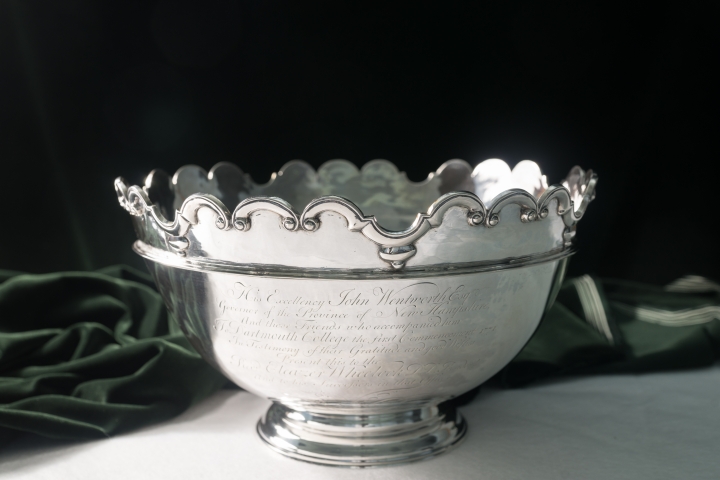About the Artifacts

The Wentworth Bowl
In 1773, John Wentworth, the royal governor of the province of New Hampshire and grantor of Dartmouth’s original charter, gave the vessel to Eleazar Wheelock, Dartmouth’s founder and first president. It was the first art object presented to Dartmouth. Over the years the bowl has become a cherished symbol of the institution’s highest office. The bowl is a monteith, an object used in the 18th century to chill wine glasses. More significantly, beginning in 1909, the bowl was incorporated into Dartmouth’s presidential inauguration ceremonies when outgoing president William Jewett Tucker passed the bowl to his successor, Ernest Fox Nichols, in what is called the Wheelock Succession.
The Flude Medal
When in academic attire, Dartmouth’s president wears the Flude Medal suspended from a gold chain. The medal was a gift to Dartmouth’s second president, John Wheelock, from John Flude of London in 1785. On its slightly convex face the medal depicts in gold the Aesop’s fable scene, The Old Man and His Sons. The reverse side, of sterling silver, has a heraldic shield that represents the earliest official flag of the United States of America and engraved dedicatory text.
The Charter
The Charter of Incorporation of Dartmouth College was signed on Dec. 13, 1769, by Royal Governor of New Hampshire John Wentworth, acting on behalf of the sovereign, King George III. Several thousand words in length, the document comprises two large sheets of parchment. At Inauguration, the charter is conveyed by the chair of the Board of Trustees to the incoming president.
Lord Dartmouth’s Cup
Lord Dartmouth’s Cup is a standing vessel of sterling silver, measuring slightly more than 2 feet in height. The cup is borne ceremoniously by the College Usher in escorting members of the Board of Trustees at Commencements, Inaugurations, and other appropriate academic occasions. Crown Jeweler Robert Garrard Jr. crafted the cup in London in 1848. The fourth Earl of Dartmouth acquired the cup and was subsequently held by succeeding earls until 1969 when the ninth Earl presented it to Dartmouth during the bicentennial.
Eagle Staff
The staff was created by Trudell Guerue ’74, a Vietnam veteran and Sicangu Lakota who came to Dartmouth after serving in the Army Airborne. He created the staff to honor 21 Dartmouth men who died in the Vietnam War.
Guerue, who was wounded in combat, presented the ceremonial staff to the Native Americans at Dartmouth organization, and it has become a traditional element of the opening festivities of Dartmouth’s annual Powwow. The staff includes feathers sheathed with the Vietnam Service Ribbon and cloth featuring 21 Purple Heart ribbons.
Wampum Belt
Gifted to then-President Philip J. Hanlon ’77 on April 26, 2022, Wampum belts have long been exchanged between Indigenous and other nations. Differing from written treaties with fixed terms, wampum belts signify the beginning of a living relationship between two parties, and their intention to continually discuss and revisit their mutual obligation to one another. According to Mohegan medicine woman and tribal historian Melissa Tantaquidgeon Zobel, “the purple beads signify a history of conflict, and the white beads symbolize cleansing.” Thus, this belt “is a joining of two peoples who have been in conflict but are now one in friendship.”